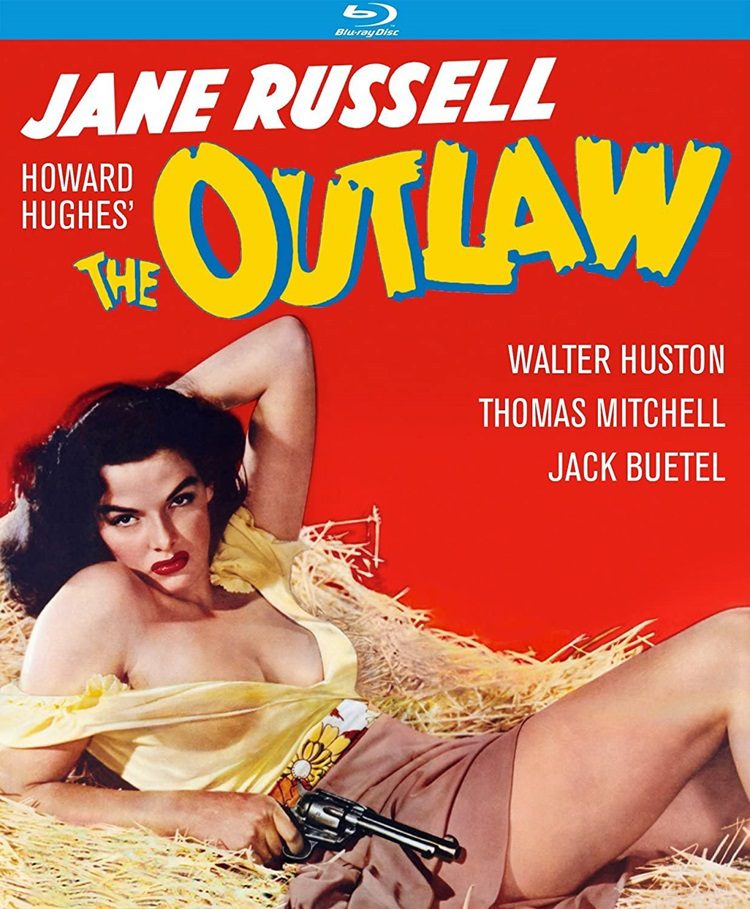
The Outlaw was produced and directed by Howard Hughes (with some uncredited directing at the beginning of the production by Howard Hawks). It is one of the more unusual westerns in cinema and not just because it is notable for introducing Jane Russell and her cleavage to audiences. The characters include legendary names of the old American West, such as Billy the Kid and Doc Holliday. The story places them in a traditional heterosexual love triangle while at the same time a more subtle homosexual love triangle is occurring with some of the same characters.
Doc Holliday (Walter Huston) comes to Lincoln, New Mexico where his old pal Pat Garrett (Thomas Mitchell) is now the sheriff. Doc finds Billy the Kid (Jack Buetel) stole his horse, but their mutual respect leads to a friendship that gnaws at Pat, who grows jealous of the pair as Pat feels replaced by the new, younger, more attractive Billy.
A stranger tries to shoot Billy but Billy kills the man first. Pat sees this as an opportunity to take Billy in, so he shoots but only wounds Billy. Doc, thinking Billy was justified in acting in self defense, shoots the gun out of Pat’s hand and the two men escape. Pat gets a posse together while Doc and Billy head to Doc’s girlfriend Rio’s (Jane Russell) place.
Earlier, she attacked Billy because he killed her brother, but her attitude changes rather (and unbelievably) quickly considering how ugly the sequence ends even though nothing is seen. Not only is she willing to help nurse Billy back to health at Doc’s request while he ventures out, but in a weirdly suggestive scene she decides to warm the feverish Billy by getting her body under the covers, to the disappoint of her mother. Once that happens, Billy recovers, and Rio starts wearing a low-cut top.
The Outlaw is more comedy than drama, and while not all the humor seems intentional, some certainly is, such as the very funny scene when Rio tires of a chicken not listening to her and the result of that. On the other hand, Victor Young’s score gets silly at times, punctuating moments and clashing with the scene. It would have been better suited for a cartoon or a comedy.
As the film progresses towards the conclusion, there’s a lot of double-crossing between the characters, so it’s never clear where anyone’s allegiances lie, which keeps the viewer engaged. Things get very weird towards as the men start revealing their feelings for each other.
Struck from a brand new 2k restoration, the video has been given a 1080p/MPEG-4 AVC encoded transfer displayed at an aspect ratio of 1.33:1. Legendary cinematographer Gregg Toland’s work is showcased well as his trademark deep-focus shots are on display, such as when Pat walks in on Doc cleaning up. The blacks are inky but do crush like the scene where Doc and Pat find Rio tied up. Whites lean towards gray.
The image shows grain, which intensifies during Billy’s return to Rio tied up, and from the smoke and sand kicked up from the Mescaleros. As kids approach Billy outside the dentist, the figures disrupt the grain and the gray color of the sky as light bleeds straight up off them. The picture has light occurrences of dirt and damage with the most egregious being white vertical scratches as Doc dissuades the posse. The HD accentuates the phoniness of the rear projection.
The audio is available in DTS-HD Master Audio 2.0. Dialogue is clear and is balanced well with the score, but a softly spoken word can be muffled so it’s too bad there are no captions include. Effects are serviceable. There is an audio commentary by film historian Troy Howarth, who is tickled by the sillier elements of the film and offers a comprehensive look at its creation. He also goes off on many interesting tangents, including the other films the characters were depicted in. There are trailers for Kino Lorber Studio Classics releases: The Outlaw, The Ox-Bow Incident, Rawhide, Man with the Gun, and Yellow Sky.
While not a traditional western, The Outlaw does enough right to make it an entertaining watch. Kino’s Blu-ray offers a good HD presentation of this 75-year-old movie.